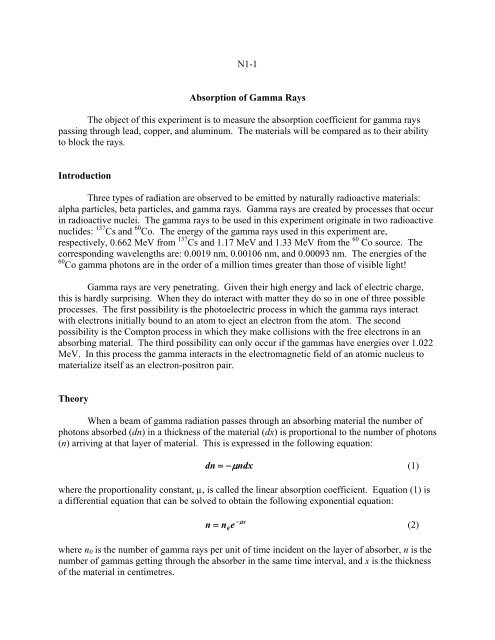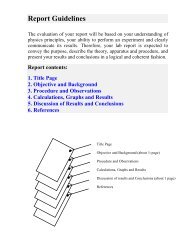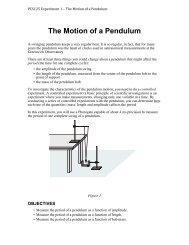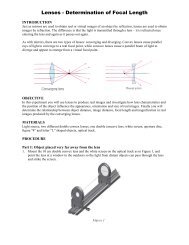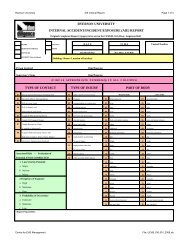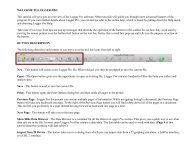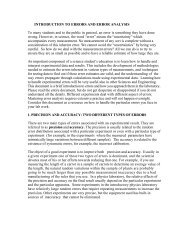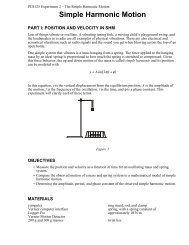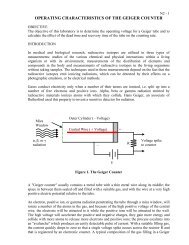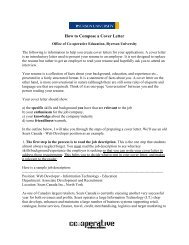Absorption of Gamma Rays - Ryerson Department of Physics
Absorption of Gamma Rays - Ryerson Department of Physics
Absorption of Gamma Rays - Ryerson Department of Physics
You also want an ePaper? Increase the reach of your titles
YUMPU automatically turns print PDFs into web optimized ePapers that Google loves.
N1-1<strong>Absorption</strong> <strong>of</strong> <strong>Gamma</strong> <strong>Rays</strong>The object <strong>of</strong> this experiment is to measure the absorption coefficient for gamma rayspassing through lead, copper, and aluminum. The materials will be compared as to their abilityto block the rays.IntroductionThree types <strong>of</strong> radiation are observed to be emitted by naturally radioactive materials:alpha particles, beta particles, and gamma rays. <strong>Gamma</strong> rays are created by processes that occurin radioactive nuclei. The gamma rays to be used in this experiment originate in two radioactivenuclides: 137 Cs and 60 Co. The energy <strong>of</strong> the gamma rays used in this experiment are,respectively, 0.662 MeV from 137 Cs and 1.17 MeV and 1.33 MeV from the 60 Co source. Thecorresponding wavelengths are: 0.0019 nm, 0.00106 nm, and 0.00093 nm. The energies <strong>of</strong> the60 Co gamma photons are in the order <strong>of</strong> a million times greater than those <strong>of</strong> visible light!<strong>Gamma</strong> rays are very penetrating. Given their high energy and lack <strong>of</strong> electric charge,this is hardly surprising. When they do interact with matter they do so in one <strong>of</strong> three possibleprocesses. The first possibility is the photoelectric process in which the gamma rays interactwith electrons initially bound to an atom to eject an electron from the atom. The secondpossibility is the Compton process in which they make collisions with the free electrons in anabsorbing material. The third possibility can only occur if the gammas have energies over 1.022MeV. In this process the gamma interacts in the electromagnetic field <strong>of</strong> an atomic nucleus tomaterialize itself as an electron-positron pair.TheoryWhen a beam <strong>of</strong> gamma radiation passes through an absorbing material the number <strong>of</strong>photons absorbed (dn) in a thickness <strong>of</strong> the material (dx) is proportional to the number <strong>of</strong> photons(n) arriving at that layer <strong>of</strong> material. This is expressed in the following equation:dn = −μndx(1)where the proportionality constant, µ, is called the linear absorption coefficient. Equation (1) isa differential equation that can be solved to obtain the following exponential equation:n−μx= n 0e(2)where n 0 is the number <strong>of</strong> gamma rays per unit <strong>of</strong> time incident on the layer <strong>of</strong> absorber, n is thenumber <strong>of</strong> gammas getting through the absorber in the same time interval, and x is the thickness<strong>of</strong> the material in centimetres.
N1-2The linear absorption coefficient will be seen to be a function <strong>of</strong> the material used toblock the gamma rays. In particular, it strongly depends on the material density. Thisdependence is revealed by dividing the linear absorption coefficient by the material density. Thenumber obtained by this division is called the mass absorption coefficient and should haveroughly the same value for all materials. If the linear absorption coefficient is in units <strong>of</strong> 1/cm,the mass absorption coefficient will have units <strong>of</strong> cm 2 /g.ApparatusThe detector is a Geiger-Muller tube. Radiation incident upon the tube enters through athin (and very delicate) mica window and into a gas filled cylinder that contains two terminalswith a high potential difference between them: one <strong>of</strong> the terminals is the outside <strong>of</strong> the cylinder(or cathode) which is negatively charged, and the other terminal is a wire that runs down thecentre <strong>of</strong> the tube (the anode) which is positively charged. Radiation moving through the gasfilledcylinder will ionise the gas. When these ions move towards either the cathode or theanode, the electric circuit is closed and a signal is sent to the scaler. The scaler is simply anadding machine that counts the number <strong>of</strong> times that a particle <strong>of</strong> radiation is detected.Figure 1 Diagram <strong>of</strong> the scaler-timer unit
N1-3Precautions1. The detector is located at the top <strong>of</strong> the opening located in the lower right hand side <strong>of</strong> theapparatus. The mica window is very thin and fragile. Do not touch it under any circumstances.2. Treat the radioactive sources with respect. They are quite weak as radioactive sourcesgo, but nevertheless, they are radioactive. Handle them only with the tongs provided. Do notput one in your pocket. Do not attempt to break their plastic containers. Keep them behind leadshielding as much as possible. Return them to the lab instructor as soon as you are finished withthem.3. One <strong>of</strong> the materials you will be using in this experiment is lead. Lead is a toxicsubstance, especially if ingested, so be sure to wash your hands immediately after the lab.Procedure1. Setting the voltage: Turn on the scaler unit. Push the H.V. (high voltage) button once.The LED screen will now show you the voltage <strong>of</strong> the anode. Using the UP and DOWN buttonsadjust the anode voltage to 360 Volts. Push the H.V. button again to have the LED screen putback on count mode (i.e. the light above the H.V. button is <strong>of</strong>f).2. Setting the timing interval: You will be counting the gamma ray incidents in one minuteintervals. Push the button marked TIME. The LED screen will now show the time (in seconds)that the timer is set for. Adjust this time until it reads 60 seconds. Push the TIME button to goback into the COUNT mode (i.e. light above the TIME button is <strong>of</strong>f).3. Sign out a 137 Cs source from your lab demonstrator (make sure you record the source aswell as the time you signed it out and the time <strong>of</strong> its return when you are done with it). Place thesource in its plastic tray at the bottom <strong>of</strong> the detector cavity. Place the plastic sheet with a holein the centre <strong>of</strong> it four or five levels away from the 137 Cs source. This plastic sheet will act as aholder for the various blockers that you will be using in the lab, and it should be located as closeto the detector as possible.4. The scaler is now ready to start counting the incident radiation. To start counting simplypress the COUNT button. The scaler will count for the amount <strong>of</strong> time the timing interval wasset for (60 seconds in this case) and the number <strong>of</strong> radiation events will be displayed on the LEDscreen. When the scaler is done counting, the light above the COUNT button will go out, andthe number <strong>of</strong> radiation events will be displayed on the LED screen. Take three one-minutecounts <strong>of</strong> the amount <strong>of</strong> radiation emitted by the 137 Cs source without any blocking (n 0 ).5. Place one sheet <strong>of</strong> lead on the plastic holder above the source and take three counts with
N1-4the blocker. Repeat this for multiple layers <strong>of</strong> lead up to four sheets. Record the thickness <strong>of</strong>each lead sheet using a micrometer.6. Repeat step 5. for copper and aluminum. Note: for each <strong>of</strong> these materials n 0 will besame as the value recorded in step 3.7. Return the 137 Cs source to your lab demonstrator and sign out a 60 Co source. Repeatsteps 3. and 4. for the 60 Co (i.e. lead only).8. Return the 60 Co source to your lab demonstrator. Remove all the blockers from thedetector cavity and take three one-minute counts for the background radiation.9. Turn down the high voltage to zero and turn <strong>of</strong>f the scaler timer.AnalysisTake the average <strong>of</strong> each set <strong>of</strong> three counts per minute. Subtract the background average fromeach average to correct for background radiation. Plot all the results on a single graph page,plotting the natural logarithm <strong>of</strong> the average counts/min against the absorber thickness incentimetres. Draw the best straight line through the points for each material. The slopes <strong>of</strong> theselines are the linear absorption coefficients. Look up the densities <strong>of</strong> the absorbing materials used.Divide each <strong>of</strong> their linear absorption coefficients by the appropriate density in g/cm 3 . The resultis called the mass absorption coefficient. Compare the results for each absorber and comment.Also compare the results for lead using the different sources and comment.


